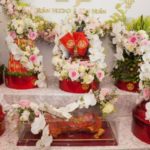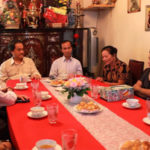Wedding customs in each region will have their own unique rituals. However, there are still many similarities in the wedding customs of our people. Let’s explore the wedding rituals of the groom’s family in the article below.
See also: What does it include? Detailed order
1. Prepare betrothal gifts
 Prepare betrothal gifts
Prepare betrothal gifts
The first ceremony that the groom’s family must prepare before going to the bride’s house to fetch her is to prepare betrothal gifts. These gifts are usually prepared by the parents or elders in the family. After checking that everything is in order, the gifts will be arranged in trays, covered, and draped with a red cloth. The betrothal gifts that the groom’s family needs to prepare include:
- Tray of cakes: Pía cake, com cake, sponge cake
- Tray of Betel and Areca
- Tray of fruits
- Tray of tea and alcohol
- Roasted pig
- Tray of Gac rice and other colored rice
- Tray of fruits, chicken, and colored rice
- Red envelope with money
- Dragon and Phoenix candle set
 Groom and his entourage
Groom and his entourage
Next, the groom must burn incense to pay respect to his ancestors before fetching the bride. This ceremony expresses reverence and respect for one’s ancestors. The parents or elders will light the incense and hand it to the groom.
After burning incense, the groom will be given a bouquet, and the betrothal gifts will be given to the people carrying the trays as they proceed to the bride’s house.
2. Wedding procession
 Groom’s family goes to the bride’s house to fetch her
Groom’s family goes to the bride’s house to fetch her
With the betrothal gifts ready, the groom’s family will organize a procession to bring the bride to their home to perform the ancestor worship ceremony and introduce her to the groom’s family. The master of ceremonies will lead the wedding procession, followed by three cars representing the groom’s and bride’s families. The bride will be transported in a flower-decorated car.
 Bride getting into the car to her husband’s house
Bride getting into the car to her husband’s house
According to the customs of Northern and Central regions, the bride’s parents will not join the procession as they are reluctant to witness their daughter leaving with her husband. In the South, however, the bride’s parents are more relaxed, and they usually join the procession to the groom’s house to witness their daughter’s wedding ceremony.
3. Ancestor worship ceremony

This is the most important ceremony, performed at the groom’s house in the presence of both families. During this ceremony, the bride will worship the ancestors, and if they are still alive, she will serve tea to the groom’s grandparents and then to her parents-in-law. After offering tea to her in-laws, the bride will be presented with jewelry or money by the groom’s elders.
 Presenting dowry
Presenting dowry
After the ancestor worship ceremony, the bride and groom are officially married. They will exchange wedding rings in front of their families and friends. This is followed by a wedding banquet where they receive blessings from their loved ones.
Each wedding custom has its own unique meaning, passed down by our ancestors. We should cherish and uphold these beautiful traditions.



































